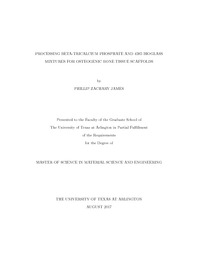
ATTENTION: The works hosted here are being migrated to a new repository that will consolidate resources, improve discoverability, and better show UTA's research impact on the global community. We will update authors as the migration progresses. Please see MavMatrix for more information.
Show simple item record
| dc.contributor.advisor | Shiakolas, Panayiotis S. | |
| dc.contributor.advisor | Aswath, Pranesh B. | |
| dc.creator | James, Phillip Zachary | |
| dc.date.accessioned | 2018-03-08T18:38:45Z | |
| dc.date.available | 2018-03-08T18:38:45Z | |
| dc.date.created | 2017-08 | |
| dc.date.issued | 2017-08-18 | |
| dc.date.submitted | August 2017 | |
| dc.identifier.uri | http://hdl.handle.net/10106/27265 | |
| dc.description.abstract | A 30% 45S5 Bioglass and 70% -tricalcium phosphate ceramic mixture, which was previously shown to be osteogenic [1], was sintered and the process was investigated as a strengthening mechanism. Samples were sintered for dwell times of 1,2, and 4 hrs at 500°C to avoid crystallization of the 45S5 Bioglass. Two different binders were used, 2% gelatin in deionized water and 2% laponite with 2% oleic acidin deionized water. The mixture was also robocasted as a slurry to evaluate the manufacturing process. Mechanical compression testing shows that the laponite with oleic acid binder acted as a sintering aid leading to a small increase in strength with longer sintering times, while the 2% gelatin binder had no clear trend in strength increase. Computed X-ray tomography (μ-CT) scans revealed no significant densication from the sintering process and scanning electron microscope (SEM) images revealed no significant changes in the microstructure which indicates that 500°C is an ineffective sintering temperature. X-ray absorption near edge structure (XANES) analysis was performed for silicon and phosphorus L₂,₃-edges and for oxygen K-edge. Silicon L₂,₃-edge data reveals that for the laponite with oleic acid binder samples, longer sintering times change the spin-orbit interaction of the 2p electrons as the bonding structure becomes more similar to sodium silicate and the laponite becomes incorporated into the SiO₂ glass network. Phosphorous L₂,₃-edge data reveals no significant changes in phosphate bonding structure which is to be expected.It is known that for the Na₂O -CaO -SiO₂ system that non-bridging oxygen atoms preferentially bond to Ca instead of Na. The oxygen K-edge data shows that the samples have an increase in bridging oxygen bonds (Si-O-Si) over 45S5 Bioglass, which indicates that after addition of the binder, there is a decrease in the amount of Na in the glass network relative to Ca. The bridging oxygen bonding decreases upon sintering but there are no significant changes for longer sintering times. For robocasting of the ceramic slurry, an engineering case study is presented to discuss issues related to process repeatability, lessons learned in implementing the process, and suggestions for future work. | |
| dc.format.mimetype | application/pdf | |
| dc.language.iso | en_US | |
| dc.subject | Tricalcium phosphate | |
| dc.subject | 45S5 Bioglass | |
| dc.subject | Robocasting | |
| dc.subject | Tissue engineering | |
| dc.subject | XANES | |
| dc.subject | Oxygen K-edge | |
| dc.subject | Silicon L-edge | |
| dc.subject | Phosphorus L-edge | |
| dc.title | PROCESSING BETA-TRICALCIUM PHOSPHATE AND 45S5 BIOGLASS MIXTURES FOR OSTEOGENIC BONE TISSUE SCAFFOLDS | |
| dc.type | Thesis | |
| dc.degree.department | Materials Science and Engineering | |
| dc.degree.name | Master of Science in Materials Science and Engineering | |
| dc.date.updated | 2018-03-08T18:40:52Z | |
| thesis.degree.department | Materials Science and Engineering | |
| thesis.degree.grantor | The University of Texas at Arlington | |
| thesis.degree.level | Masters | |
| thesis.degree.name | Master of Science in Materials Science and Engineering | |
| dc.type.material | text | |
| dc.creator.orcid | 0000-0002-9359-5191 | |
Files in this item
- Name:
- JAMES-THESIS-2017.pdf
- Size:
- 43.36Mb
- Format:
- PDF
This item appears in the following Collection(s)
Show simple item record


